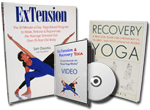ExTension and Recovery Yoga Teacher Trainings merge asana training (yoga exercises) with an uncomplicated study of anatomy, physiology, and kinesiology. Through an exploration of straightforward physiological principles and laws and applying them to a series of “yoga exercise tests,” participants learn how to maximize yoga's benefits and minimize its liability.
Appropriate for teachers and serious students of any discipline or level, this Foundational Training teaches the dynamics of flexibility, strength, and endurance for everyone, from world-class athletes to chronically ill and injured people - and for everyone in between.
An ideal basic or "foundational" teacher training encompasses five hours a day for five days. However, knowing that not all yoga organizations or schools can organize full-week trainings, they can be easily compressed into shorter time-frames; even weekend trainings. Clearly, less material is covered during a single visit, but basically, I can create anything to suit your schedule and needs.
What follows is our basic Teacher Training Outline. The actual amount of material and the detail we explore in your Training depends up on the amount of time we have together
I. A Non-Judgmental Comparison of Yoga to Other Forms of Body Movement
A. Yoga and yoga-based movement -- Inner (intrinsic) movement
B. Exercise, sport and physical therapy -- Outer (extrinsic) movement
II. How Yoga Works
A. Law: Uniform or constant fact or principle
- Davis Law: If muscle ends are brought closer together, the pull on tonus is increased, which shortens the muscle (may even cause hypertrophy); and if muscle ends are separated beyond normal, tonus is lessened or lost (thus the muscle becomes "weak"
- Arndt-Schultz Law: Weak stimuli activate physiological processes; very strong stimuli inhibit them
- Pflugers's Laws:
- Law of Unilaterality: If a mild irritation be applied to one or more sensory nerves, the movement will take place usually on one side only, and that side which is irritated
- Law of Symmetry: If the stimulation be sufficiently increased, motor reaction is manifested, not only by the irritated side, but also in similar muscles on the opposite side of the body
- Law of Intensity: Reflex movements are usually more intense on the side of irritation; at times the movements of the opposite side equal them in intensity, but they are usually less pronounced
- Law of Radiation: If the excitation continues to increase, it is propagated upward and reactions take place through centrifugal nerves coming up form the cord segments higher up
- Law of Generalization: When the irritation becomes very intense, it is propagated in the medulla oblongata, which becomes a focus from which stimuli radiate to all parts of the cord, causing a general contraction of all muscles of the body
4. Law of Facilitation: When an impulse has passed once through a certain set of neurons to the exclusion of others, it will tend to take the same course on future occasions, and each time it traverses this path, the resistance will be smaller
5. Hilton's Law: A nerve trunk which supplies a joint also supplies the muscles of the joint and the skin over the insertions of such muscles (must also pass through fascia)
B. Application of Bachin Charts to yoga
1. The Muscular System
2. The Skeletal System
3. The Plumb Line
C. Physiological effects of yoga exercise and breath management upon:
1. Fascia (learning to less to get more)
2. Muscle, Tendon, Ligament
a. Stretching vs. traumatizing (e.g., when soft tissue is over stretched)
b. Strengthening vs. distressing (e.g., when soft tissue is overloaded)
c. Endurance building vs. weakening (e.g., when muscle shakes)
d. Pumping action: circulatory & lymphatic systems
3. Organs and glands: circulatory stimulation and toning
4. Nervous system: reduce over stimulation to relax and strengthen
5. Restoration
a. stress reduction
b. profound affect upon injury and illness
D. Psychological effects
1. How yoga exercise and breath management create/enhance feelings of
a. Stimulation (heating)
b. Relaxation (cooling)
c. Introversion
d. Extroversion
e. Sensing & Intuition
f. Thinking & Feeling
g. Judging and Perceiving
E. Brain Wave Research: yoga exercise and breath management congruency yields brain congruency
II. THEORY OF TEACHING
A. Teaching the very stiff, the very flexible, the injured or ill student
1. Theory of Perfection
2. Trying vs. doing
B. Yoga props: their use and necessity
1. Reduces body stress and promotes "attainable' movement
2. Exact measurements are not required
C. Advantages and disadvantages of adjusting students
D. Use and effect of language
1. Positive vs. neutral vs. negative words
(verbalizing reality vs. potential vs. limitation)
2. Singular vs. plural
3. Assuming for everyone
E. Verbalizing and teaching from students' perspective
F. Detail
1. Overkill
2. Superfluous language
G. Demonstrating vs. teaching by "doing"
III. Introducing yoga exercise & breath management for Fully Ambulatory, Semi-ambulatory, and Non-ambulatory Students
A. Purpose
1. Stretch
2. Strengthen
3. Tone
4. Relax
B. Muscle(s) being used
1. Origins
2. Insertions
3. Actions
C. Indications
D. Contraindications
 Return to Top
Return to Top



